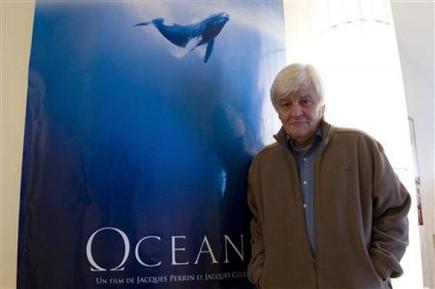-
-
MSNBC Marquee
Woods’ wife reportedly revising prenup
Now that Tiger Woods has admitted to “transgressions,” many wonder what is next for his marriage.
Movies
New film "Oceans" gives fish-eye view of sea life
(Agencies)
Updated: 2009-12-08 08:53

PARIS - New French film "Oceans" not only allows viewers to swim among the fish, but opens a window on underwater lives filled with emotion and fraught with danger.
It is over fifty years since celebrated French diver and filmmaker Jacques Cousteau shot the documentary "The Silent World" and technical advances have made it easier to capture life from the perspective of a fish, the film's directors say.
"We invented all these devices to be fish amongst the fish, to witness what we have done to our environment and, when there are big catches or pollution, to see it as the fish see it," one of directors, Jacques Perrin, told Reuters.
It is more than 10 years since "Microcosmos," the award-winning exploration of the life of insects which Perrin narrated and which provided an eerily close-up look at tiny creatures living in grass.
Thanks to new camera techniques, "Oceans" allows for jarringly violent shots of spider crab wars, full-tilt dolphin chases, portraits of sea creatures caring for their young and wonderfully ugly oddities such as the Asian sheeps-head wrasse.
"Our machines do not open with one spectacular character but with an intimacy with an animal one has never seen until now and which, just like that, we become attached to," added Perrin.
New methods include encasing cameras in special boxes, allowing divers to glide alongside skates or swim shoulder to fin with large white sharks.
After two years of preparation, four years of filming and one of editing, "Oceans" comes out in France on January 27, a month after the environmental summit in Copenhagen.
Perrin, a supporter of French environmentalist Nicolas Hulot, said he does not feel the need to preach but hopes to contribute to the debate on environmental protection.
"Oceans" was shot in sea sanctuaries over more than 70 expeditions across the world. Some of the film's scenes take place in a museum of extinct species, made more haunting with the knowledge that the animals died out because of humankind.
"That was the case with the dolphin in the Yangtze (river) which we had planned to film, but the last one disappeared during filming," said co-director Jacques Cluzaud.
One camera, placed in a "mid-air mid-water" device, follows a seal as it curiously noses a supermarket trolley on the filthy seabed, then surfaces to take in a grey industrial complex at the water's edge.
In one scene, a shark caught in a trawling net is thrown back into the water, bleeding heavily from where its fin was cut off to be eaten as a delicacy. The gasping shark is shown drifting down to the dark seabed, followed by a plume of blood.
Perrin is nevertheless optimistic on the future of oceans.
"The cry of hope is stronger than the cry of alarm," Perrin said. "The sea is still rich, we've made it bleed and mutilated it, but it is there and if we want, things could start anew."





